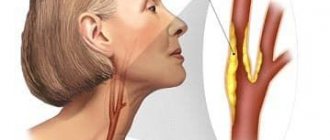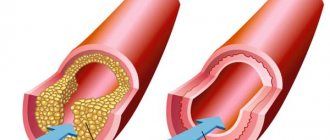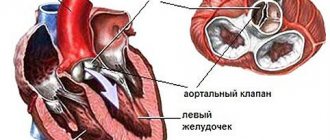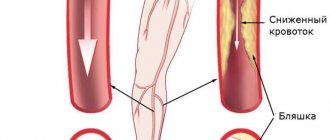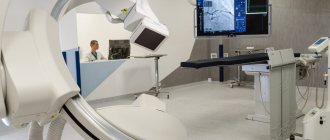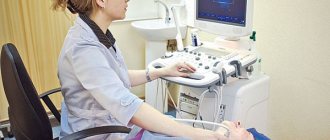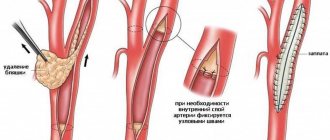Description
Non-stenotic atherosclerosis - what is it? Generally speaking, these are the consequences of an incorrect lifestyle. Plaques form on the surface of blood vessels, which is caused by excessive levels of “bad” cholesterol in the blood. Pathological processes do not concern the walls of blood vessels, but their openings.
Plaques, which are blood clots, are deposits of lipid tissue. With atherosclerosis, they grow inside the vessels, which impedes normal blood flow. In the non-stenotic form of the disease, they do not slow down the blood flow.
Cholesterol problems often arise in youth and remain asymptomatic for years. Symptoms begin to be actively expressed upon reaching 50 years of age. Changes in the walls of blood vessels affect various internal organs, including large, vital ones.
It is a mistake to believe that non-stenotic atherosclerosis, like other forms of the disease, affects only the elderly.
Treatment options
Diagnosis of the disease
Diagnosis begins with collecting information and complaints, identifying chronic diseases. The patient examination includes mandatory blood pressure measurement and weighing. Anamnesis allows you to determine the stage of atherosclerosis, and the presence of several symptoms at once indicates vascular pathology.
During a visit to the doctor, auscultation of the carotid arteries is performed. First, the visibility of vascular pulsation is determined, then they are listened to with a stethoscope. The device is applied to the vessels with a funnel-shaped tip. The purpose of listening is to identify pathological arterial noises that cause softening of the brain and ischemia.
Further diagnosis uses additional methods. Ultrasound of blood vessels allows us to identify the degree of narrowing, echographic symptoms of a non-stenotic type and the level of severity of the disease. The presence of a plaque in the carotid artery is determined by a significant slowdown in blood flow in one place.
Duplex diagnostics includes:
- Black and white ultrasound image of blood vessels;
- Dopplerography based on measurements of blood velocity.
- Angiography is performed after injection of a contrast agent into the artery. It is needed to increase the accuracy of identifying a problem area with moderate damage to the walls of the carotid arteries. The diagnostic complex additionally includes MRI and CT to assess the physical condition of the choroid and its structure.
Treatment of the disease
The doctor prescribes treatment for atherosclerosis of the vessels of the neck and carotid arteries based on test results. In medicine, there are 3 directions of treatment: non-drug, medicinal and surgical.
The non-drug method involves:
- Nutrition correction;
- Increased physical activity;
- Physiotherapy and massage;
- Psychologist consultations.
The diet for atherosclerosis of the carotid arteries is aimed at reducing animal fats and saturated acids in the diet. Doctors recommend including more fish, seafood and poultry, as well as eating a lot of fresh or steamed vegetables, fruits, and dried fruits. You should avoid salt and butter. It is better to replace wheat bread with rye bread, and sweets with honey, natural jam and cookies made from rye flour or cereal.
- Non-stenotic and stenotic atherosclerosis of BCA - what is it, symptoms and treatment
Drug therapy involves the prescription of drugs that have vasodilating and cholesterol-lowering properties.
The following groups of medications are usually used to treat vascular disease:
- Statins;
- Medicines that normalize metabolism;
- Strengthening the arterial wall;
- Antihypertensive drugs;
- Medicines that correct the functioning of the endocrine system;
- Antiplatelet agents.
Surgical methods are used when important vessels are blocked and the patient’s condition rapidly deteriorates. Depending on the indications, several types of surgical intervention are performed. The method of carotid endacterectomy involves removing the atherosclerotic plaque that has blocked the vessel. Stenting and balloon angioplasty is the installation of an artificial stent and a special balloon inside the vessel. Air is supplied to the balloon, which leads to expansion of the vascular lumen.
During thrombolysis, a drug is injected into the artery. This method does not apply to abdominal operations. Thrombolysis dissolves cholesterol plaques and cleanses blood vessels. For small deposits, plaque removal using a laser is used. The operation takes only a few minutes and does not pose any danger to the patient's health.
Unconventional methods of treatment
The use of folk remedies for atherosclerosis is possible only in consultation with a doctor and in the early stages of the disease. To improve the patency of blood vessels, use an alcoholic tincture of garlic. It is prepared like this: 250 g of chopped garlic cloves are poured with a liter of clean and high-quality vodka. The infusion is kept for 21 days in a dark place. Take the medicine according to the following scheme:
- 1 day - 1 drop of infusion;
- Day 2 - 2 drops of infusion;
- Add one drop every day until day 25 of the course;
- Starting from day 26, reduce one drop at a time.
Take the infusion with water or warm milk.
To treat the disease, you can also use a recipe with pine needles. The drink allows you to eliminate blood supply disturbances, cleanse blood vessels, and improve overall well-being. 5 tbsp. young pine needles are mixed with 3 tbsp. rose hips and 1 tbsp. onion peels. The dry mixture is poured with a liter of boiling water and placed on low heat. Boil for about 10 minutes. The finished broth is covered with a warm blanket and left for several hours. The resulting volume of decoction should be divided into equal portions and drunk throughout the day. The course of treatment is 4 months.
Another simple recipe is strawberry or pomegranate juice. The drink has a pronounced diuretic effect, improves salt metabolism and rids the body of harmful microorganisms. It is recommended to drink 2-3 glasses of juice throughout the day.
Herbal remedies are no less effective in fighting the disease. Grind and mix:
- 2 tbsp. dill seeds;
- 2 tbsp. hawthorn flowers;
- 2 tbsp. coltsfoot and yarrow;
- 3 tbsp. horsetail;
- 4 tbsp motherwort;
- 5 tbsp. marsh common cucumber.
Pour 1 tbsp of boiling water over a glass. mixture, stand for an hour and strain. Drink 100 ml of infusion three times a day. Course - 2 months. You can also take clover infusion. 4 tbsp dry crushed flowers are poured with 500 ml of vodka. Infuse the drink for 10 days. The infusion is taken in courses, each of which lasts a month. The break between doses is 10-14 days. Daily dosage - 20 drops of infusion, dissolved in a glass of water at lunch and the same amount before bed.
- What is stenosing atherosclerosis of the brachiocephalic arteries and how to treat it?
Kinds
Any arteries or vessels can be affected. The lesions described below have the most pronounced symptoms. Each species has its own characteristics, most often several of them develop simultaneously. Damage to the blood vessels of the brachiocephalic arteries, aorta, and lower extremities is considered especially common.
Brachiocephalic arteries
For the body to be viable, it is necessary to ensure uninterrupted blood flow to the brain. The following main ways are involved:
- through the carotid artery;
- left subclavian artery;
- brachiocephalic trunk.
The brachiocephalic artery is one of the branches of the aorta through which blood flow reaches the brain. Due to its parameters and accessibility, cholesterol plaques often form in it, affecting the walls of blood vessels. The main symptoms of non-stenotic atherosclerosis of the extracranial brachiocephalic arteries are:
- frequent tinnitus;
- dizziness;
- migraine attacks;
- fainting state;
- numbness of the limbs;
- prostration.
Symptoms of damage to parts of the bts also include hair loss, brittle nails, deterioration of the skin, and changes in gait. Many people view these problems as cosmetic, delaying treatment.
Non-stenotic atherosclerosis bca is considered one of the most dangerous forms of atherosclerosis. Damage to the extracranial vessels that supply blood to the brain and neck causes a lot of discomfort, worsening the quality of life. However, given that this often manifests itself in older people, such symptoms are attributed to age and left unattended. Non-stenotic atherosclerosis of the brachiocephalic arteries may also involve damage to the carotid arteries.
The larger the plaque becomes, the stronger the disruption of the blood flow system, given the proximity of the arteries to the brain, this condition is life-threatening
Aorta
The aorta is the largest blood vessel. Often, those parts of the aorta that are located in the chest and/or peritoneum are susceptible to non-stenotic atherosclerosis of the aorta. The danger lies in the non-obviousness of the symptoms; even if the plaques have affected every centimeter of the aorta, the person may not feel it.
The main signs of aortic plaque damage include:
- painful sensations in the chest, peritoneum;
- frequent headaches;
- causeless coughing attacks;
- hoarseness, hoarseness.
Arteries of the lower extremities
Painful sensations appear in the hips, lower back, buttocks, and the pain syndrome is especially pronounced in the calf muscles. The development of the disease occurs in several stages, most patients detect it in the second or third:
- First. Pain in the lower extremities is felt only after intense physical activity. Many people ignore it, chalking it up to fatigue or poor fitness.
- Second. Painful sensations occur even after minor exertion. Short walking and doing household chores are accompanied by severe discomfort.
- Third. Due to pain, any load on the legs is limited. A person cannot stand for a long time, the maximum possible distance to move is no more than 50 m.
- Fourth. Wounds appear on the limbs, developing into gangrene. This happens due to a deficiency of nutrients, vital microelements to the feet.
Other types of disease
Non-stenotic atherosclerosis can also affect other elastic arteries in the body, although this is less common. In addition to the sections of the brachiocephalic arteries, aorta and lower extremities, plaques can form on:
- main arteries;
- pulmonary;
- subclavian;
- carotid;
- extracranial.
The disruption of the arteries occurs gradually, first the plaques affect the large ones, then the smaller ones. The deposition of cholesterol plaques can occur chaotically, therefore, when at least some of them appear on one type of artery, there is immediately a risk of their formation on others - the entire cardiovascular system may suffer.
What should you know about atherosclerosis of the brachiocephalic vessels?
Knowledge about the symptoms, as well as methods of treatment for atherosclerosis of the brachiocephalic arteries, is required by absolutely every person, and this is due to several reasons, namely:
- First of all, it should be noted that today atherosclerosis is generally one of the most common diseases, which, as a rule, doctors diagnose in every fifth person under the age of thirty, and in every fourth of five people of retirement age. Non-stenotic atherosclerosis of the extracranial parts of the BCA is being diagnosed more and more often.
- The described disease is included in the top three in terms of its prevalence among other atherosclerotic diseases.
- The severity, as well as the danger of the consequences, is due to the fact that with this pathology the arteries that supply the human brain with blood are damaged. The acute as well as chronic nature of cerebrovascular accidents develops extremely quickly.
Causes
The main reason for clogging of arteries due to the formation of cholesterol plaques in the inner lining is a violation of lipid metabolism in the body. Often the person himself is to blame for this condition; it arises due to an incorrect lifestyle. The most common provocateurs of nonstenosing atherosclerosis are:
- obesity;
- smoking, alcohol abuse, drug use;
- sedentary lifestyle;
- hypertension (high blood pressure);
- improper diet with excessive amounts of animal fats;
- genetic predisposition;
- constant stress.
Usually, the formation of plaques in the arteries occurs when several factors appear simultaneously. For example, hypertension in people over 45 years of age occurs in every second person. If a person has bad habits and does not play sports, the likelihood of developing non-stenotic atherosclerosis increases significantly.
Some people don't understand how bad habits relate to arterial health. The thing is that under the influence of alcohol, nicotine, and other negative factors, the elasticity of the walls of blood vessels decreases, which makes them a favorable basis for the appearance of plaques.
Causes and risk factors
The disease is mainly diagnosed in people over 40 years of age. The exact cause of the formation of the pathology is currently unknown. Risk factors contributing to the development of the disease:
- The man smokes. A bad habit is harmful to the whole body, but it has a particularly negative effect on blood vessels. Vascular walls become brittle, hypertensive attacks and vasoconstriction occur. This leads to atherosclerosis.
- High cholesterol levels. It is this that forms the basis of atherosclerotic plaques. Fat covers the vascular and arterial walls, as a result the lumen gradually narrows. Blood circulation is impaired, which leads to the formation of the disease.
- Hypertension. At first, atherosclerosis forms without stenosis, but then the disease progresses, the vessels are damaged, become fragile and lose elasticity. Stenotic atherosclerosis of the BCA is formed.
- Hormonal balance is disrupted (often due to the use of contraceptives).
- A person leads a sedentary lifestyle.
- Predisposition at the genetic level.
Diagnostics
A cardiologist treats vascular pathologies. However, patients with non-stenotic atherosclerosis rarely go to the hospital with suspicion. As a rule, problems are identified during a blood test, after which the patient is sent for a detailed examination.
Damage to the BC and other types of arteries can be detected using diagnostic methods such as:
- Doppler ultrasound;
- Ultrasound of the heart;
- CT scan of the brain and heart;
- donating blood for various indicators.
Doppler ultrasound allows you to assess the general condition of the walls of blood vessels, determine the speed of blood flow - the result allows you to confirm or refute the suspicion of non-stenotic atherosclerosis
Diagnostic results allow you to establish a diagnosis and prescribe treatment. It is impossible to identify cholesterol plaques on your own.
Diagnostic features
- To make a diagnosis, a thorough examination of the patient is necessary. Only after an adequate examination can the correct treatment of atherosclerosis of the carotid arteries be prescribed. Diagnosis begins with collecting anamnesis. The doctor must determine the risk factors for the disease.
- It is important to establish auscultation (listening) of the carotid arteries.
- It is necessary to measure blood pressure, since elevated tonometer readings may indicate disturbances in the functioning of the carotid arteries.
- Ultrasound with Doppler scanning of blood vessels is also mandatory. This examination method is completely safe and painless and allows you to accurately establish the diagnosis.
If the examination results are questionable, the patient must be prescribed the following types of diagnostics:
- Computed tomography (CT). It makes it possible to accurately determine the structure of the arteries. A CT scan must be performed using a contrast agent.
- Magnetic resonance imaging.
- Angiography must be performed using special contrast agents. Due to the risk of separation of the atherosclerotic plaque, this type of diagnosis is now rarely used.
Treatment
Only comprehensive treatment will be effective, which includes diet therapy, giving up bad habits, and the use of medications. Thanks to this, it will be possible not only to normalize the level of cholesterol in the blood, but also to improve the general condition of the patient, preventing relapse. Therapy includes:
- Taking statins. This is the main group of drugs that allows you to normalize the amount of lipids in plasma. They block the production of “bad cholesterol”, accelerating the production of “good” cholesterol.
- Other medications. These include anticoagulants, antiplatelet agents, and medications that improve brain function. Also, the choice of medications depends on the cause of atherosclerosis. If it develops against the background of hypertension, medications are prescribed to normalize blood pressure.
- Lifestyle. A complete cessation of bad habits, normalization of sleep and rest patterns, and moderate exercise are required. A diet is also prescribed that involves excluding animal fats from the diet.
In advanced cases, surgery may be necessary. It is used if medication does not bring results or the patient goes to the hospital too late. After diagnosis, endovascular surgery is prescribed - stenting of the affected vessel. If the plaque is large and the artery is almost completely blocked, it may be necessary to remove part of it, and a prosthesis is installed in this place.
Treatment of cerebral atherosclerosis
It is not only the neurologist who treats patients with atherosclerosis in our center. We treat the disease comprehensively with the involvement of doctors from different specialties. This approach makes the recovery process comfortable, gives better results and helps patients return to their normal lives sooner.
The basis for the treatment of cerebral atherosclerosis is the correct selection of nutrition. On the one hand, the diet combines a complete diet with individually designed physical activity. On the other hand, medications help compensate for the pathological process and reduce the harmful effects of the disease on the body.
Medicines used:
- diuretics;
- drugs that normalize lipid and blood sugar levels;
- vitamins;
- drugs to improve cerebral circulation;
- means for normalizing blood pressure and heart rate;
- thrombolytic agents, etc.
Diet therapy
Usually the diet is prescribed for life. Any form of atherosclerosis is endogenous and completely depends on the diet and lifestyle of the patient. The table below shows permitted and prohibited products.
| Allowed | Prohibited |
| Lean meats – chicken, turkey, beef | Fatty meats, lard |
| Fish | Trans fats (margarine, spread) |
| Fresh fruits, vegetables | Sausages, frankfurters, other smoked meats |
| Sea kale | Mayonnaise, all fatty sauces |
| Bran, cereals | Fast food |
| Low-fat dairy products, cheeses | Fatty dairy products, cheeses |
| Chicory, herbal teas | Baking, flour |
Fast food is considered one of the most harmful foods that provokes high cholesterol, it is especially important to give it up for life
Diagnosis of carotid artery diseases
To diagnose diseases of the carotid arteries, the doctor must conduct a detailed survey of the patient in order to find out about all the symptoms that appear, the history of the disease and the patient’s health characteristics. The most important information in this case is information about the patient’s smoking habits, as well as about the characteristics of his blood pressure. After this, the doctor examines the patient. Auscultation of the carotid arteries is mandatory to detect eddy current. It indicates the presence of narrowings. , blood pressure measurement is required .
Doppler ultrasound examination of the carotid arteries is considered an informative method in the process of diagnosing carotid artery disease. Ultrasound allows an adequate assessment of the structure of the vessel and the blood flow in it. As a rule, such a study allows you to accurately determine the presence of carotid artery disease. In more rare cases, to establish an accurate diagnosis, the doctor needs additional information, which can be obtained by performing a computed tomography or CT angiography.
The angiography method is based on the use of a contrast agent and the use of X-rays. This technique allows you to ultimately obtain a particularly accurate image of the arteries and examine all the changes that have occurred in them. However, such a study is fraught with the risk of injury to the atherosclerotic plaque and, as a consequence, the manifestation of a transient ischemic attack or stroke. Therefore, such a study is rarely prescribed.
Prevention
Preventive measures must be observed by everyone, especially those who have a genetic predisposition to atherosclerosis. They are also important in preventing relapse after successful recovery. The basic rules of prevention include:
- rejection of bad habits;
- choosing a suitable sport taking into account age and health status;
- maintaining normal weight;
- avoiding overeating;
- limiting stress;
- limiting the addition of salt to the diet;
- adherence to the principles of proper nutrition.
Also, an important preventive measure is to consult a doctor in a timely manner if you suspect any health problems.
Thus, non-stenotic atherosclerosis is a serious problem associated with the formation of cholesterol plaques on the walls of the arteries. The sooner it can be diagnosed, the greater the consequences can be avoided. Treatment requires complex therapy: medication, diet therapy, and lifestyle changes.
Classification and causes of diseases
In some cases, pathologies of the brachiocephalic arteries are provoked by anomalies of the anatomical structure - excessive tortuosity of the vessels or fibromuscular dysplasia. Somewhat more often this occurs against the background of extravasal compression. However, in total, the listed reasons account for no more than 10% of all cases. The remaining 90% of catalysts occur in atherosclerotic lesions.
The causes of disturbances in the activity of the brachiocephalic arteries include:
- Atherosclerosis of the carotid, subclavian or vertebral artery;
- Primary and secondary vasculitis (arteritis);
- Persistent low or high blood pressure (hypo- and hypertension);
- Osteochondrosis of the cervical spine (and associated vascular compression);
- Severe heart pathologies;
- Developmental abnormalities or chronic diseases of the aorta;
- Aneurysms;
- Diabetic angiopathy;
- Vascular malformations;
- Dyscirculatory disorders (including vegetative-vascular dystonia);
- Mechanical injuries to the neck and head.
Atherosclerosis, which is the most common provocateur of diseases, is often caused by third-party endogenous and exogenous factors. These include long-term smoking, mature and old age, hypercholesterolemia, diabetes mellitus, unhealthy lifestyle and poor health in general.
With atherosclerosis of the brachiocephalic arteries, a persistent circulatory disorder in the brain occurs. It varies in intensity and severity, but almost always leads to tragic outcomes. In 80% of cases, such pathologies lead to a major stroke. The importance of timely contact with a cardiologist and vascular surgeon when symptoms are detected cannot be overestimated - sometimes early adequate treatment saves the patient from disability and death.
The formation of atherosclerotic plaque in the brachiocephalic arteries is a long process; traditionally it begins at a young age. A neoplasm gradually grows in the wall of a certain vessel, leading to a narrowing of the lumen of the artery, or its complete blockage.
Sometimes specialists diagnose non-stenotic atherosclerosis. This means that the lumen of the vessel is blocked by an atherosclerotic plaque by less than 50%, i.e. the disease does not entail potential critical risks. Without observation and treatment, non-stenotic atherosclerosis transforms into stenotic atherosclerosis, provoking vascular occlusion and serious disruption of the blood supply to the brain.
Symptoms of obliterating atherosclerosis
Source: The VeinCare Center / YouTube
In rare cases, atherosclerosis obliterans manifests itself as acute thrombosis or embolism of the arteries. Most often, at the initial stage of development of the pathology, a person does not experience any unpleasant sensations.
Symptoms appear gradually as the lumen of the vessels narrows:
- the first signs are a feeling of coldness in the legs, partial numbness of the fingers and toes, a sensation of “pins and needles”, burning, pale skin on the legs;
- pain and tension in the calf muscles during long walks, easing after a short rest;
- intermittent claudication is the main symptom of the pathology, which appears in the early stages and persists as it develops, intensifying when climbing stairs or uphill;
- pain in the gluteal and thigh muscles (Leriche syndrome);
- change in skin color on the legs: at first it becomes much lighter than on other parts of the body, and then acquires a purplish-bluish tint.
With the development of pathology, atrophy of the subcutaneous tissue occurs, hair on the legs begins to fall out, nails deteriorate, and the stratum corneum of the epidermis thickens. Any scratch or cut of the skin on the sore leg can lead to the appearance of necrotic areas and the development of gangrene.
The course of the disease occurs in one of three ways:
- In 14% of patients, the disease is acute with the rapid development of trophic disorders and gangrene. With the development of gangrene, amputation of the affected area of the limb is indicated;
- in 44% of cases, seasonal exacerbations are observed; the process can be slowed down with timely treatment;
- 42% of cases occur in the chronic form, when vascular patency is maintained and trophic disorders do not occur.
People often mistake the symptoms of atherosclerosis obliterans for ordinary fatigue. In old age, leg pain and cramps during long walks are associated with problems with the veins and joints, so a visit to the doctor is postponed until the pain becomes constant. Delayed seeking of medical help significantly reduces the likelihood of recovery.
Symptoms of atherosclerosis of the carotid arteries
The initial stages of carotid atherosclerosis are rarely accompanied by any symptoms. For a long time, a person is unaware of nascent atherosclerotic plaques. Symptoms appear only when the lumen of the vessel is significantly narrowed (more than 80%) or blocked. Such people are at risk of developing a stroke or transient ischemic attack (ministroke).
The symptoms of these two conditions are the same, because the reason is the same: the brain does not receive enough blood. However, with an ischemic attack this phenomenon is temporary, so the symptoms quickly pass, and with a true stroke it is long enough to cause irreversible changes. However, mini-strokes should not be ignored. As a rule, they are harbingers of a stroke.
Symptoms of carotid atherosclerosis:
- sudden weakness, numbness of the muscles of the face, limbs (usually only one side);
- slurred speech;
- disturbance of consciousness;
- sudden deterioration of vision (in one/both eyes);
- sharp, severe headache;
- problems with swallowing;
- dizziness/loss of consciousness.
With such a clinical picture, you must immediately call an ambulance.
Atherosclerotic disease of the arteries of the lower extremities without stenosis
As mentioned above, with this type of atherosclerosis, the vessel is blocked by less than 50%.
Frequent patient complaints
In the initial stages of the disease, patients, as a rule, do not make complaints, or patients do not pay attention to the symptoms.
The main features include:
- pain in the thighs, buttocks, lower back, calf muscles;
- increased pain with physical activity;
cold skin in the legs;- nausea;
- dizziness;
- feeling of numbness in the limbs, “crawling”, tingling;
- change in skin color (pallor);
- poor wound healing;
- cramps in the muscles of the lower extremities;
- itching, peeling of the skin of the legs;
- roughening of nails and skin of the feet;
- cracks, hair loss on legs.
Criteria necessary for diagnosis:
- Systolic blood pressure (BP) increases, while diastolic blood pressure does not increase.
- The skin of the legs, especially the feet, is cold to the touch.
- Blood test for: cholesterol, triglycerides, low-density lipoproteins – the indicators are increased; high density lipoproteins – reduced.
- Weakening of pulsation in the main arteries of the limbs.
- Doppler ultrasound. Sonographic signs of pathology: the presence and determination of the size of plaques, slow blood flow in the vessels, their damage and wall injuries.
- Angiography - places of vascular narrowing are visible (up to 50% of the lumen).
- Computed tomography is also partially capable of detecting all of the above changes.
Directions in treatment
Therapy is selected individually for each patient, but basically it includes:
Statins: simvastatin, atorvastatin, rosuvastatin (in the absence of contraindications).- Vasodilators (antispasmodics): nitrates, papaverine, dibazol.
- For the prevention of thrombosis: antiplatelet agents - aspirin, chimes, clopidogrel; anticoagulants – warfarin, rivaroxaban, dabigatran.
- Vitamin preparations and antioxidants.
- A healthy lifestyle aimed at losing weight.
- Blood pressure control - it is not recommended to allow systolic blood pressure to rise above 140 mmHg.
- Physical education classes, swimming, exercise bike.
- Treatment of chronic diseases.
- Refusal of alcohol, smoking, excessive consumption of coffee and tea.
- Elimination of animal fats and salt, increasing the amount of fruits and vegetables in the diet.
The duration of drug therapy is 1.5 – 2 months. The course must be repeated 4 times a year.
Prognosis for future life and rules of observation with a doctor
This disease should not be taken as a death sentence. Narrowing of arteries without stenosis is not a critical point. The most important thing is to try to stop the progression of the atherosclerotic process, which can be achieved by following the above recommendations.
Treatment of obliterating atherosclerosis
One of the treatment methods is electrotherapy.
Source: Nicole Patterson / YouTube The choice of treatment method is determined by the severity of symptoms, the stage of development of the pathological process, and the nature of the course of the disease. Depending on the patient’s condition, conservative therapy or surgery is prescribed.
Conservative therapy
Conservative treatment includes medications, physiotherapy, and spa treatment. It is also necessary to eliminate risk factors for the development of the pathological process - quit smoking, normalize lipid metabolism and blood pressure. Conservative methods give a positive effect only at the initial stage of the disease.
The complex of drug therapy includes the following drugs:
- reducing red blood cell aggregation;
- thin the blood and prevent the formation of blood clots;
- antispasmodic;
- vitamins;
- painkillers.
Physiotherapeutic techniques:
- electrophoresis;
- UHF;
- magnetic therapy and others.
These procedures are aimed at improving blood circulation and strengthening the walls of blood vessels in the lower extremities.
For obliterating atherosclerosis, balneological procedures are indicated. They accelerate metabolic processes and activate blood circulation: radon, hydrogen sulfide and other baths, applications with healing mud.
To heal trophic ulcers, dressings with drugs that promote skin healing and accelerate the process of tissue regeneration are prescribed.
Surgery
Surgery is indicated in later stages of the disease and in the absence of effect from conservative treatment.
The choice of surgical intervention method is determined by the individual characteristics of the pathology and the degree of arterial damage. Modern surgery offers several effective methods of endovascular or open surgery:
- arterial stenting - installation of a special frame to prevent narrowing of the vascular bed;
- endarterectomy - excision of atherosclerotic plaques on the inner wall of the vessel;
- thromboembolectomy - removal of thrombotic masses from the affected arteries;
- bypass - creating a path to bypass the affected area of the artery;
- replacement of the affected artery with a prosthesis or a segment of the patient’s own healthy vein;
- profundoplasty – expansion of the affected area by plastic surgery.
If surgery is not possible, palliative measures are taken to improve blood circulation.
You should not delay contacting a doctor, because at stage 4 the pathological process can only be stopped by amputating the affected leg to a level that takes into account the boundaries of the ischemic lesion. At the same time, timely assistance, such as reconstructive vascular surgery, will make it possible to save the limb with a high probability.
